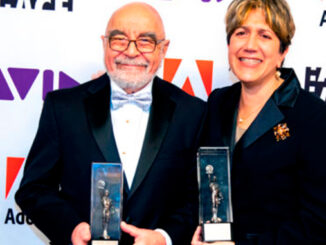
By Matt McFarland
When I was g rowing up in Omaha, Nebraska, during the ’70s and ’80s, movies were a refuge from the Midwestern winters and my favorite source of entertainment during the summer — absent watching Cornhusker Football with my father.
My mother would take me to the solitude of the movie theater, and I remember running through the aisles of Omaha’s Cinerama Theater during “Star Wars” as my mom begged me to sit still. The summer movie program would pick me up weekly in a school bus to watch camp classics like “Godzilla” and “Infra Man.” Home alone on most summer days, I would pull out my parent’s 8mm projector and watch sample reels of Chaplin classics. My dad would regularly project home movies. The light projecting memories and stories on the screen fascinated me. I was mesmerized by storytelling through images. I’d stare out my window, writing stories that I envisioned being projected one day.
As the ’80s approached, Super 8 film gave way to VHS. My mom began a vast collection, bending my ear with movie trivia about actors from our hometown, like Brando and Fonda. I spent the ’80s and high school absorbed in classics that would influence my writing.
College and the weather pushed me to Tempe, Arizona, to pursue creative writing. A friend and I would shoot small scenes on his video camera. Through sheer grace and serendipity, Arizona State began a screenwriting program with Stephen Geller, known for his adaptation of “Slaughterhouse Five.” I jumped at the chance to learn from this man whose talent and generosity proved key to my development, and I wrote screenplays with a new sense of purpose until the special MFA program abruptly ended.
Looking for a creative outlet, I found an active independent film community at Scottsdale Community College, with 16mm cameras, rewind benches, and an early Avid. Having all of this within reach, I could simply grab a camera and go shoot. I accidentally flashed the first roll of film as I was loading a Canon Scoopic. I wasn’t sure how to read the light meter, and I ran over my foot with our wheelchair dolly. But when dailies came back from the lab, I was shocked to see a beautiful image despite my many mistakes. The alchemy captivated me.
I was “all in,” so I sold my car and bought an Arriflex 16BL to shoot my newest feature screenplay. I bartended to buy film stock and would shoot on the weekends with help from unpaid friends. After money and favors ran out, my production stopped short at 36 pages shot. I sat in my garage projecting dailies on my Bell & Howell, wondering what was next. I had no more money, but I had the Arri 16BL, so I sold myself as a DP. This afforded me the opportunity to quickly gather a lot of experience in the local indie film community. On what would be my last feature in Arizona, I met an actress, and, as one does, I followed her to Los Angeles.
There, ready to be a big-time screen-writer and cinematographer, my ego met reality: I needed a “real” job. Through luck and a fortunate connection, I accepted a great job at P.O.P. Film where I learned to scan and record major motion pictures onto film. It was there that I discovered color grading. Trained by the best to use an eye loupe and lightbox to color match digital visual effects shots to prints from the lab, I began grading. Eventually, I became manager of that department, all the while grading more and more. This led me to recording out digital and HD features to film, beginning with Oliver Stone’s “Comandante” (2003), a political documentary about Fidel Castro.
The era of the Digital Intermediate (DI) came calling. The process was expensive and out of reach for many, so when I found myself out of work, I opened a DI house, Cranium Filmworks, to accommodate the indie market. I set out to bring the cost of DI’s down to give everyone a chance at this revolutionary process. I had my successes, but the economy was crashing, and large studios were dipping their toes into my indie market.
If you can’t beat ’em, join ’em. I shut down my company and became a DI and remastering colorist at Warner Bros. Motion Picture Imaging, which was my first union gig. This transition was possible because of previous relationships, connections, and work experience that I had accumulated.
After nine years at Warner Bros. and five at Paramount, I’ve had the opportunity to grade some renowned features, classics, and animation. My journey has been one of transition as I embraced the road that opened before me. I have found that through trust in the process, and through learning and being kind, it didn’t matter if I had set out to be a director, DP, or colorist. The ongoing journey into an art form I love has been the reward. ■
Matt McFarland is a senior colorist with a diverse background who has color graded DIs and classic titles for Warner Bros. and Paramount Pictures such as “Almost Famous,” “Election,” “Key Largo,” “The Hunchback of Notre Dame,” “Storks,” and “Blended.” Matt can be reached at matt_ mcfarland@yahoo.com.





